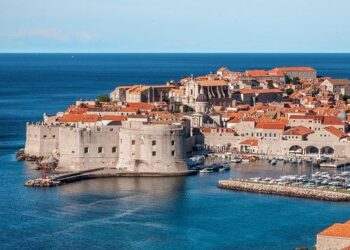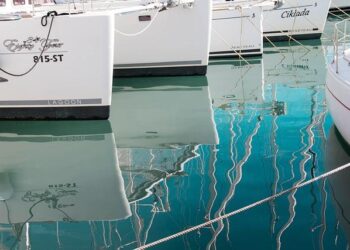Istria, Croatia’s northwestern peninsula, is rapidly gaining recognition as a premier year-round travel destination, thanks to its picturesque towns, vibrant cultural heritage, and notably affordable post-season offerings. As tourism trends shift toward more sustainable and off-peak experiences, Istria stands out by combining scenic coastal landscapes with historic charm and a rich culinary scene. This growing appeal is drawing visitors beyond the traditional summer months, positioning the region as an attractive option for travelers seeking both value and authenticity throughout the year.
Istria’s Charming Coastal Towns Offer Scenic Getaways Beyond the Summer Rush
Nestled along the azure edges of the Adriatic, Istria’s coastal towns reveal an enchanting blend of history, nature, and tranquility once the summer crowds disperse. Places like Rovinj and PoreÄŤ transform into serene havens where cobbled streets wind past colorful facades and quaint marinas, inviting travelers to slow down and savor the moment. The mild autumn climate complements leisurely seaside strolls and alfresco dining, allowing visitors to explore charming piazzas, sample fresh seafood, and enjoy local wines without the typical tourist rush. These towns embody an authentic Istrian charm that flourishes beyond peak season, presenting an ideal escape for those seeking a more intimate connection with Croatia’s coastal culture.
Beyond their visual appeal, these towns offer a wealth of activities and experiences uniquely tailored to the off-season traveler, including:
- Walking and cycling trails through olive groves and vineyards
- Local artisan markets featuring handmade crafts and regional delicacies
- Historic landmarks such as ancient Roman ruins and medieval churches open for serene exploration
- Festivals and cultural events celebrating Istrian heritage with smaller crowds
Visitors will find that the combination of peaceful scenery, cultural richness, and affordable accommodations makes these coastal gems the perfect destinations for scenic getaways year-round.
| Town | Highlight | Best Off-Season Month |
|---|---|---|
| Rovinj | Sunset Harbor Views | October |
| PoreÄŤ | UNESCO Euphrasian Basilica | November |
| Motovun | Hilltop Vineyards | September |
| Bale | Medieval Streets & Art Galleries | October |
Exploring Istria’s Cultural Treasures: Festivals, Cuisine, and Historic Landmarks
Istria’s vibrant cultural calendar showcases a blend of traditional festivals and contemporary celebrations that captivate visitors throughout the year. Events such as the Motovun Film Festival and the Pula Film Festival highlight the region’s artistic spirit, while local festivities like the Truffle Hunting Season and Kastav Carnival offer immersive experiences into Istrian customs. These gatherings not only celebrate heritage but also support local artisans and performers, ensuring that the cultural heartbeat remains strong across all seasons.
Gastronomy and history intertwine seamlessly across Istria, inviting travelers to explore its renowned cuisine alongside remarkable landmarks. Savoring dishes crafted from fresh, regional ingredients-such as prosciutto, truffles, and Malvazija wine-is an essential part of the experience. Pair culinary adventures with visits to historic sites including the Roman amphitheater in Pula, medieval hilltop towns like GroĹľnjan, and the Venetian-inspired architecture of Rovinj. The table below highlights key elements of Istrian culture for quick reference:
| Aspect | Highlight | Best Time to Experience |
|---|---|---|
| Festivals | Motovun Film Festival | July |
| Cuisine | Truffle Dishes & Malvazija Wine | October – January |
| Landmarks | Pula Roman Amphitheater | Year-round |
| Historic Towns | GroĹľnjan & Rovinj | Spring & Autumn |
Affordable Travel Tips for Visiting Istria in the Post-Season Months
Exploring Istria during the shoulder months unlocks a treasure trove of budget-friendly opportunities amid breathtaking landscapes and centuries-old towns. Travelers can enjoy significant savings on accommodation as many boutique hotels and guesthouses offer up to 40% off their regular prices after the peak summer season. Opting for local guesthouses or agriturismos not only ensures authentic stays but also supports the regional economy. Public transportation, including buses connecting major Istrian towns like Rovinj, PoreÄŤ, and Pula, operates reliably and affordably, replacing expensive car rentals and enabling leisurely travel across the peninsula.
To maximize the value of your visit, consider these tips:
- Dine at local konobas: Traditional eateries showcase Istrian delicacies at lower prices post-season, with seasonal truffles and fresh seafood in abundant supply.
- Take advantage of free cultural events: Many small towns host autumn festivals, art exhibitions, and wine tastings without entrance fees.
- Schedule hikes and bike tours: Milder temperatures and quieter trails offer ideal conditions for outdoor enthusiasts without the summer crowds.
- Book ferry rides on weekdays: Discounts on routes to nearby islands or coastal areas often apply outside weekends and holidays.
| Expense | Peak Season Cost | Post-Season Cost | Potential Savings |
|---|---|---|---|
| Hotel Night | €100 | €60 | 40% |
| Local Dining (per meal) | €25 | €15 | 40% |
| Bus Ticket (one-way) | €8 | €5 | 38% |
| Bike Rental (per day) | €20 | €12 | 40% |
To Wrap It Up
As Istria continues to captivate travelers with its picturesque towns, vibrant cultural heritage, and enticing post-season affordability, the region firmly establishes itself as a year-round destination in Croatia’s competitive tourism landscape. Whether seeking the charm of historic streets or the warmth of local traditions, visitors are discovering that Istria offers an enriching experience beyond the typical summer months. With these enduring qualities, Istria is poised to remain a standout choice for tourists looking to explore the Adriatic coast through all seasons.
















